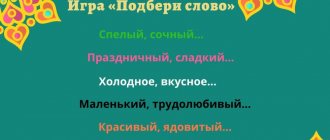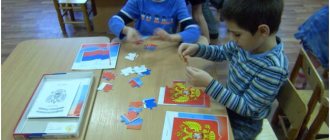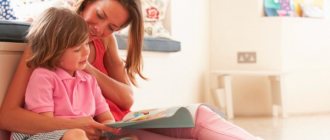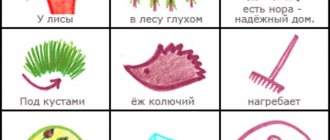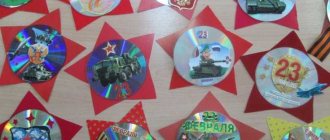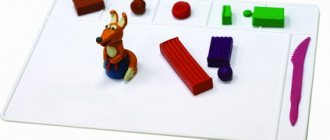Commentary on the presentation Visual modeling method
Visual modeling method
Slide 1
Considering that at this time children are oversaturated with information, it is necessary that the learning process be interesting, entertaining, and developmental for them.
One of the factors facilitating the process of developing coherent speech, according to S. L. Rubinshtein, A. M. Leushina, L. V. Elkonin, is clarity. In preschool age, visual material is more easily absorbed than verbal material. Examining objects and paintings helps children name objects, their characteristic features, and actions performed with them.
Slide 2
The relevance of using visual modeling in working with preschoolers is that:
• firstly, a preschool child is very flexible and easy to teach, but children are characterized by rapid fatigue and loss of interest in activities. Using visual modeling creates interest and helps solve this problem;
• secondly, the use of symbolic analogy facilitates and speeds up the process of memorizing and assimilating material, and forms techniques for working with memory. After all, one of the rules for strengthening memory says: “When you teach, write down, draw diagrams, diagrams, draw graphs”;
• thirdly, using a graphic analogy, we teach children to see the main thing and systematize the acquired knowledge.
Slide 3
“MODELING” is the study of any phenomena or processes by constructing and studying models. Modeling has models as its object.
“MODEL” is any image (mental and conditional; images, descriptions, diagram, drawing, graph, plan) of any process or phenomenon (the original of this model), used as a substitute.
Visual modeling – reproducing the essential properties of the object under study, creating its substitute and working with it.
A visual model of an utterance acts as a plan that ensures coherence and consistency in the child’s stories .
Slide 4
L.A. Venger identified 3 stages of modeling:
1. Using a ready-made symbol or model.
At this stage, the adult demonstrates a finished model or symbol, the children examine and disassemble it, and then reproduce information based on this model.
2. Drawing up a model of a teacher together with children.
Where the teacher teaches the identification of signs of difference and similarity, at the same time gives the task to sequentially select and lay out models that replace these signs, organizes a comparison of two objects with each other, gradually increases the number of compared objects to three or four;
teaches children to model features that are essential or significant for activity. 3. Independent compilation of models
.
The teacher leads the creation of models of elementary concepts such as “fish”, “birds”, “animals”, “domestic animals”, “wild animals”, “plants”, “living”, “non-living”, etc.
Slide 5
In order for a model, as a visual and practical means of cognition, to fulfill its function, it must meet a number of
requirements:
- Clearly display the basic properties and relationships that are the object of cognition;
— Be easy to understand and accessible to create actions with it;
— Vividly and clearly convey with its help those properties and relationships that must be mastered;
- Facilitate cognition.
The model as a form of clarity can be used in all age groups.
Slide 6
In the psychological and pedagogical literature, a number of patterns in the formation of modeling in preschoolers have been identified:
- Modeling is performed on material familiar to children, based on knowledge acquired in the classroom or in everyday life;
— It is advisable to start with modeling individual specific situations, and later – with building models that have a generalized nature;
— You should start with iconic models, i.e. maintaining a certain similarity with the modeled object, constantly moving to conditionally symbolic images of relationships;
— You should start with modeling spatial relationships, and then move on to modeling temporal, logical, etc.;
— Learning to model is easier if it begins with the use of ready-made models and then their construction;
— The process of learning to model ends with the internalization of actions, i.e. transferring planning to an internal plan.
Slide 7
In didactics, there are 3 types of models:
1. An object model in the form of a physical structure of an object or objects that are naturally connected (a planar model of a figure that reproduces its main parts, design features, proportions, relationships of parts in space).
2. Subject-schematic model. Here, the essential components identified in the object of cognition and the connections between them are indicated with the help of objects—substitutes and graphic signs. For example, strips of paper of different colors, images of geometric shapes.
3. Graphic models (graphs, formulas, diagrams). (Where they convey in general (conditionally) the characteristics, connections and relationships of any phenomena or a model that reflects the essential, clearly perceived characteristics of a given systematic group of animals: habitat, shape and size of the body, body cover, structure of the limbs, etc.
Slide 8
The modeling is based on
. A real object can be replaced in children's activities by another object, image, sign.
Symbols of various types can act as conditional substitutes (elements of the model):
Slide 9
Visual modeling tools are used to teach children:
- retelling;
- compiling a descriptive story about individual objects;
- compiling stories based on a series of paintings, plot and landscape paintings; - writing stories from personal experience;
— storytelling (with elements of creativity);
- compiling a comparative descriptive story;
- compiling a story according to plan;
- compiling a creative story based on silhouette images;
- composing and guessing riddles; - ability to conduct a conversation, dialogue.
At the first stage of training, the role of models is performed by concrete objects, and then symbolic substitutes can be used.
Slide 10
At the initial stage of work,
geometric shapes
, their shape and color resembling the object being replaced.
For example, a green triangle is a Christmas tree, a gray circle is a mouse, etc. At subsequent stages, children choose substitutes, without taking into account the external signs of the object, focused on qualitative characteristics (evil, kind, cowardly, etc.). good characters - light colors, evil characters - dark colors.
Elements of a story plan compiled from a painting can be silhouetted images of its objects, both clearly present in the painting and those that can be identified only by indirect signs.
Retelling
- the easiest type of monologue speech. A visual model acts as a story outline.
Work on developing the skill of retelling using the modeling method involves the formation of the following skills:
- mastering the principle of replacing heroes or actions of a fairy tale or story with various objects or schematic images;
- development of the ability to convey the plot of a story using substitute objects.
start learning visual modeling techniques with short Russian fairy tales
: “Masha and the Bear”, “Three Bears”, “Squirrel and Wolf” L.N. Tolstoy, “The Jackdaw and the Jug”, “The Forest and the Mouse” by V. Bianchi, “Three Kittens” by V. Suteev.
In order for children to learn to tell these short tales, various substitute objects are used to depict parts of the story or fairy tale. For example, the fairy tale “Turnip” is told by an adult, and children gradually display symbols - substitutes for the heroes of the fairy tale and the events taking place in the fairy tale.
At this stage, children are taught to manipulate the elements of the model in parallel with the reading of a specific fragment of a fairy tale, that is, each fragment of a fairy tale is shown and put on the board during the reading process.
Slide 11
Then we move on to retelling using graphic diagrams
.
Having the opportunity to look at a graphic diagram, the child was much easier to compose a logical story. The graphic diagram does not serve as a hint, but as a teaching tool.
Slide 12
When teaching retelling, you can use pictograms. With their help, children are taught retelling based on a picture, which you can draw yourself as you tell the tale, and then you can ask the children to draw and retell it using your own drawing.
Slide 13 A type of schematic model is
a mnemonic table .
Its purpose is to encode the content of the text in the form of a diagram using conventional symbols, so that in the future the child can, based on this type of clarity, decode, remember and reproduce a fairy tale, story, poem. The mnemonic table graphically displays information about characters, objects of the surrounding world, natural phenomena, and events. When children see all the characters, the child already concentrates his attention on the correct construction of sentences, on reproducing the necessary expressions in his speech.
Slide 14
Mnemonic tables are especially effective when learning poems. The bottom line is this: for each word or small phrase, a picture (image) is created; Thus, the entire poem is sketched schematically. After this, the child reproduces the entire poem from memory, using a graphic image. Today, there are a huge number of ready-made mnemonic tables and illustrations for poetry.
Slide 15 Reference pictures
These include subject pictures, plot pictures, and a series of plot pictures.
Slide 16
Compiling a story based on a plot picture
is a much more difficult stage compared to retelling a finished text, but at the same time the child masters the skills of retelling. It is difficult for a child to “construct the situation” depicted in the picture, come up with a development of events and competently finish his story. You can use this technique: give children cards with fragments of a picture and invite them to make up sentences, then a large picture is displayed, and the children find their fragments from it. Children use picture symbols to make up separate sentences. The end result is a coherent story.
Slide 17
I suggest you look at the example of the painting “Winter Fun”.
Winter has come./ The sun rarely shines,/ light snowflakes are spinning and falling to the ground outside.
Snow lies on the ground / on the roofs of houses. / It’s cold outside, frost has drawn lace patterns on the windows. / But children are not afraid of frost / and the cold wind. / They sled / skate / make snowmen./
Slide 18
Compiling a plot story using the technique of fragmentary storytelling - a contrasting frame.
The picture proposed for the story is divided into 4 parts, which are covered with cardboard rectangles of different colors. The child, gradually revealing each of the 4 parts of the picture, talks about each fragment, combining them into one plot. Work on each of the fragments is similar to the work on compiling a description of the whole picture. Variation in children's stories is achieved through their choice of the color of the rectangle that they open first.
Slide 19 Based on a series of paintings
Before giving children the task of composing a story based on a series of paintings
,
you need to carefully examine all the pictures in the series, note what is important in each of them, and determine the storyline. And then ask the child to arrange the story pictures in a logical sequence, answer the questions with complete answers and compose a story independently.
Slide 20 Compiling descriptive stories.
When teaching children how to write descriptive stories, you can use various diagrams to describe vegetables and fruits, clothes, dishes, animals, seasons, including “Schemes for writing descriptive stories” by T.A.
Tkachenko. There are many varieties, here are some of them. We first use diagrams to describe an individual item belonging to a particular group, and then move on to comparative description schemes. The use of diagrams makes it much easier for children to master coherent speech; the presence of a plan makes stories clear, coherent and consistent. Slide 21, 22
Slide 23, 24, 25
In the process of developing the skill of composing a descriptive story and a story along a certain plot line, models are used, including supporting stylized pictures that correspond to the main parts of the story.
In a story, a model is a scheme for establishing methods of connection between sentences and between the structural parts of a coherent statement. Thus, three main types of story models are used, reflecting different ways of connecting phrases: / - chain connection
(sentences “link” together, one follows from the other);
/ - parallel connection
(sentences are compared or opposed to each other);
/ - radial connection
(the object is named and each sentence reveals one of its characteristics).
Slide 26
A story with creative elements
is a story invented by children with an independent choice of content (situations, actions, images), a logically constructed plot, expressed in an appropriate verbal form. These are invented stories that are the result of children's imagination, requiring the child to have a developed imagination, imaginative thinking, and the ability to independently model the scheme of the story. Specific characters here can be replaced with silhouette images (possibly made of black paper), which allows you to be creative in describing the appearance of the heroes, their characters and the actions performed by these heroes;
Children are shown silhouettes of animals, birds, plants, which can be cut out of paper or cardboard. You can give the beginning of a fairy tale: “Once upon a time, in a distant forest, and so on.” Children themselves compose the sequence of the plot, determine its beginning and end, and come up with characters and appearance for their heroes. At subsequent stages, the child independently chooses silhouettes for the model and composes a story on his own.
Slide 27 Conclusion:
Thus, we can conclude:
the use of the visual modeling method significantly facilitates the process of children mastering the skills of coherent speech and allows them to successfully overcome shortcomings in its development. The model makes it possible to successfully develop all cognitive processes in children, optimize the process of transition from visual-effective thinking to figurative thinking, and form verbal and logical thinking. In general, working with models is a kind of creative process, multivariate, including enormous developmental potential. The use of the method of visual modeling of a coherent statement increases children's interest in this type of activity and allows them to achieve significant results.
The modeling method can be confidently called a technology of developmental education, since it is characterized by all the features of technology:
1. Learning through the modeling method is carried out in the joint activity of an adult and a child, is in the nature of an interrelated activity and assumes the active participation of both parties in the educational process;
2. Learning through this method involves the use of certain, specific techniques and ways of organizing educational activities.
3. Modeling presupposes clear design, planning, and clear organization of the learning process.
4. The use of this method dictates the need to create special conditions for the disclosure, realization and development of the child’s personal potential.
Modeling
is based on the principle of replacing real objects with objects, schematic images, and signs.
For example, to choose a method for removing dust from plants, it is important to highlight such characteristics as the number of leaves and the nature of their surface. Their color and shape are indifferent, unimportant for this activity. To distract from these signs, modeling is necessary.
The teacher helps children select and use models that are free from unnecessary properties and signs, which could be:
graphic diagrams
, any
subject substitute images
or
signs.
Modeling
, as an active independent activity, is used by the teacher along with the demonstration of the model.
As children understand the method of substituting signs, connections between real objects and their models, it becomes possible to involve children in joint modeling with the teacher, and then in independent modeling.
Actions with models are carried out in the following sequence:
- substitution (at first, models are offered ready-made, and then children come up with conditional substitutes on their own);
- use of ready-made models (starting from 3-4 years);
- building models: according to conditions, according to one’s own plan, according to a real situation (from 5-6 years old).
Supporting schemes are an attempt to use visual, motor, and associative memory to solve cognitive problems. Schemes, symbols, models are the conclusions, the result, the essence of the material that the child must learn. They should be “born” before the eyes of children in the form of drawings, diagrams, and tables.
Modeling
recommended for use
when reading fiction
. To teach coherent speech, schematic images of characters and the actions they perform are used. First, a picture-schematic plan of the semantic sequence of parts of the listened text of a work of art is created. Gradually, the child develops generalized ideas about the logical sequence of the text, which he orients himself towards in independent speech activity. A poem, fairy tale or story read to a child can be drawn. This is an effective way to identify the content and sequence of actions, certain relationships between characters.
Modeling begins with replacing some objects with others (real - conditional).
One of the most effective ways of learning are modeling methods (real, mathematical, visual, symbolic, mental). Modeling excludes the formal transfer of knowledge - the study of an object or phenomenon occurs in the course of intense practical and mental activity, developing the thinking and creative abilities of a person of any age.
The method of visual modeling (layout) develops spatial imagination, allowing you to perceive complex information and visually represent abstract concepts.
Visual modeling – reproducing the essential properties of the object under study, creating its substitute and working with it.
The validity of the method of visualization, in which or about which a speech act occurs, was pointed out by teachers and psychologists S.L. Rubinshtein, L.V. Elkonin, A.M. Leushina, L.A. Wenger. The importance of modeling the utterance plan has been repeatedly emphasized by V.K. Vorobyova and V.P. Glukhov.
Scientists identify two main factors that facilitate the process of developing coherent speech. The first, according to S. L. Rubinstein, L. V. Elkonin, is visibility. The second, according to L.S. Vygotsky - the creation of an internal plan of utterance.
“MODELING” is the study of any phenomena or processes by constructing and studying models. Modeling has models as its object.
“MODEL” is any image (mental and conditional; images, descriptions, diagram, drawing, graph, plan) of any process or phenomenon (the original of this model), used as a substitute.
An adult not only introduces the child to the world around him, but also teaches methods of examination, observation, the ability to highlight the essence, and establish relationships. The process of learning about the world is not easy for a child and support diagrams, symbols, visual models denoting phenomena and objects are very helpful in this process.
In preschool age, thinking is visual-effective and visual-figurative, and not verbal-logical, therefore for children, it is much more useful to see reality than to hear a verbal story.
Visual modeling is the reproduction of the essential properties of the object being studied, the creation of its substitute and work with it.
A model is an object
which is used as a "surrogate", a representative of another object for a specific purpose.
A model is an object that has essential features of the original object. You can create and use different object models. The model, compared to the original object, contains less information .
Models can be: figurative, iconic, mixed, natural. The visual modeling method includes the following steps
:
Assimilation and analysis of sensory material;
Translating it into sign-symbolic language;
Working with a model and allowing children to be as active as possible in speech activity, while maintaining their interest.
Actions with models are carried out in the following sequence:
1. substitution (at first the models are offered ready-made, and then the children come up with conditional substitutes on their own);
2. use of ready-made models (starting from 3-4 years);
3.building models: according to conditions, according to one’s own plans, according to a real situation (from 5-6 years old).
Supporting schemes are an attempt to use visual, motor, and associative memory to solve cognitive problems. Schemes, symbols, models are the conclusions, the result, the essence of the material that the child must learn. They should be “born” before the eyes of children in the form of drawings, diagrams, and tables.
In teaching coherent speech, the visual modeling method is used with all types of coherent utterances:
descriptive story;
retelling;
compiling stories based on a painting and a series of paintings;
Visual modeling is the reproduction of the essential properties of the object under study, the creation of its substitute and work with it. In preschool age, visual material is more easily absorbed than verbal material. Authors such as Elkonin, Wenger, Egorova consider it advisable to use visual modeling because it is accessible to children and also develops mental abilities, because children learn to compare and generalize. The use of models develops memory, clarifies children's knowledge, develops activity and independence in assimilation of information about what is being studied. Wenger, Dyachenko modeling experts identified 3 stages: 1. Using a ready-made symbol or model. At this stage, the adult demonstrates a finished model or symbol, the children examine and disassemble it, and then reproduce information based on this model. 2. Drawing up a model of a teacher together with children. 3. Independent compilation of models.
The above facts directed my attention to the development and application of subject models in teaching, which, of course, serves as a means of organizing and systematizing the child’s experience. Independent construction of models indicates the degree of formation of internal, ideal forms of modeling, which represent the core of mental abilities. Mastering logical forms of thinking is necessary in the future, during school education.
The main principles of organizing classes with preschool children, along with general didactic principles, are the subjectivity and clarity of teaching, which develops the focus of learning. Subjectivity refers to the organization of learning in such a way that the subject being studied is, if possible, perceived by all senses: hearing, vision, touch, smell, tactile sensations. Objectivity presupposes the consistent replacement of a living, natural object with a subject-schematic model. One of the factors that facilitate the process of developing coherent speech, according to L.V. Elkonin, is clarity
. Visual learning involves the use in the classroom, in addition to natural objects, of various types of visual aids: paintings, drawings, tables, diagrams, and technical teaching aids.
The developmental orientation of education involves the use of methods and techniques that involve the development of the child’s higher mental functions: perception, memory, attention, thinking, etc. Examining objects and paintings helps children name objects, their characteristic features, and actions performed with them. The second auxiliary factor is the creation of an utterance plan
. The significance of this fact was pointed out by the famous psychologist L.S. Vygodsky. He noted the importance of sequential placement in the preliminary program, the scheme of all specific elements of the utterance, and also that each link of the utterance should be replaced in time by the next.
But children have difficulties in the following:
- independent determination of the main properties and characteristics of an object;
— establishing the sequence of presentation of the identified signs;
- retention in memory of this sequence, which is the plan of the story-description;
To avoid these difficulties, I used model diagrams to compile descriptive stories about toys, vegetables, birds, animals, dishes, clothes, seasons, transport, etc.
Conclusion:
The above facts directed my attention to the development and application of subject models in teaching, which, of course, serves as a means of organizing and systematizing the child’s experience. Independent construction of models indicates the degree of formation of internal, ideal forms of modeling, which represent the core of mental abilities. Mastering logical forms of thinking is necessary in the future, during school education.
Teaching storytelling
1. Narration based on instructions or demonstrated actions.
The child is given instructions, (Go to the table, take a red ball and a blue ball) the rest of the children watch what he is doing and answer the question: What did Kolya do? Gradually the tasks become more difficult. children must remember and perform a larger number of actions, and then accurately describe the sequence of their implementation. The instruction is then told to only one child, while the others describe how to carry it out.
2. Stories descriptions.
A) Description of an object based on an object picture.
The object of the story should be well known to the child. The description is always constructed in a certain clear sequence.
- What is this?
- Shape, size, color.
— Added (material, taste, touch)
- Components.
— Application.
B)
Stories based on plot pictures
Stories based on plot pictures are of great importance for the development of independent speech skills.
While working on a story, children master the skill of dialogical speech (answering a question).
Compiling a story based on a plot picture is built in a clear logical sequence:
- Time, place.
-Characters.
- Surrounding objects.
- Actions, relationships.
Then a story is written on the following questions:
- When it was? Where?
- Who is on the hill (right, left, center)?
- Who goes down the slide? Who makes a snowman? Who's running around
children? What mood are the children in?
3. Stories based on a series of plot pictures.
Working through a series of plot pictures allows the child to understand the sequence of events. The child learns to highlight the main points in the content of the story.
Types of jobs:
According to the plot pictures laid out.
— Consideration
-Reading a story
-Coming up with a story for a series of pictures.
- Independent alignment of pictures to a given text.
- Illustration of the story by children
- Work on each picture.
4. Retelling of literary texts
This type of work can only be carried out when the child has phrasal speech. When selecting texts, it is important to take into account the individual (speech and intellectual) capabilities of children. Texts should be accessible to the child in terms of content and manner of presentation.
Before reading the story, the meaning of difficult words is explained to the children, and these words are pronounced together with the children. A short conversation is held leading the children to read the work. After reading the story, questions are asked to find out whether the children understood the story or not. At different stages of teaching retelling, different types of retelling are used:
— The adult retells it, and the child complements it
- Storytelling according to a plan or using diagrams.
- Retelling “in a chain”, when one child begins the retelling, another continues, and the third finishes, etc.
- Retelling in person, such as simple dramatization, is often used.
For children whose level of development of coherent speech is quite high, other types of work can be carried out:
Selective retelling
. Children are given the task of identifying from the story only that which relates to a given action or character.
Brief retelling.
The child does not tell everything, but only the most important, essential things.
Creative storytelling.
- retelling the text and its continuation with the addition of facts,
events from the lives of the heroes.
- compiling a story from several texts on a given topic.
- writing a story with a continuation.
- writing a story based on your personal experience
analogies with what was heard.
Innovative forms of work on composing a story.
Description of the item according to the diagram.
1. Description of an item using a schematic sketch (used for a separate item)
2. Description of the item using a general schematic sketch (used when describing items
belonging to the same classification: wild animals, vegetables, dishes, toys, etc.)
3. Description of objects using a general schematic sketch
more often used relating to a specific class: living - fish,
animals, birds, insects; inanimate objects - dishes, clothes, toys, etc.)
4. Comparison of objects based on a general schematic sketch.
(instead of a question mark, two subject pictures are placed, which are compared by
schematic sketch.
Retelling using schematic plot pictures
- Work based on a plot picture using a schematic sketch.
Many items and their quantities are depicted schematically).
2. Retelling the story in poetic form using a series of pictures using
schematic sketch.
Moving storytelling using modernization.
1. Compiling a story in dynamics using plot pictures.
2. Compilation of a comic story, its modernization in the process of storytelling.
3. Compiling a linear story with different types of reading it.
Using pie charts to write a story.
(The use of pie charts when working on a story is very convenient for complex topics: Motherland, Moscow, Evenkia, space, army, etc.)
Compilation of combined stories.
